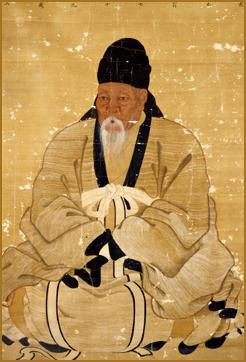Gwon Sang-ha facts for kids
Quick facts for kids
Kwon Sang-ha
권상하 |
|
|---|---|
 |
|
| Left State Councillor | |
| In office November 6, 1717 – March 14, 1720 |
|
| Preceded by | Yi I-myeong |
| Succeeded by | Yi Geo-myeong |
| Right State Councillor | |
| In office June 20, 1717 – November 6, 1717 |
|
| Preceded by | Yi I-myeong |
| Succeeded by | Cho Tae-chae |
| Personal details | |
| Born | 1641 |
| Died | September 2, 1721 (aged 79–80) |
| Korean name | |
| Hangul |
권상하
|
| Hanja |
權尙夏
|
| Revised Romanization | Gwon Sangha |
| McCune–Reischauer | Kwŏn Sangha |
| Art name | |
| Hangul |
수암, 한수재
|
| Hanja |
遂菴, 寒水齋
|
| Revised Romanization | Suam, Hansujae |
| McCune–Reischauer | Suam, Hansujae |
| Courtesy name | |
| Hangul |
치도
|
| Hanja |
致道
|
| Revised Romanization | Chido |
| McCune–Reischauer | Ch'ido |
| Posthumous name | |
| Hangul |
문순
|
| Hanja |
文純
|
| Revised Romanization | Munsun |
| McCune–Reischauer | Munsun |
Gwon Sangha (1641 – September 2, 1721) was an important politician and scholar during Korea's Joseon Dynasty. He was a follower of Neo-Confucianism, which was a major way of thinking at the time. Gwon Sangha was a member of the Westerner political group and later became the second leader of a powerful subgroup called the Noron. His special pen names were Suam and Hansujae.
He learned from a famous scholar named Song Jun-gil. Gwon Sangha also carried on the ideas of another very important scholar, Song Si-yeol.
Who Was Gwon Sangha?
Gwon Sangha was born in 1641. He grew up to be a highly respected person in the Joseon Dynasty, which was the last kingdom of Korea. He was known for his deep understanding of Neo-Confucianism. This was a system of thought that guided how people lived and how the government worked.
Gwon Sangha was not just a scholar; he was also active in politics. He belonged to a political group known as the Westerner party. Within this party, he became a key figure in the Noron faction. This shows he was a very influential person in his time.
His Important Roles
Gwon Sangha held very high positions in the Joseon government. He served as the Right State Councillor from June 1717 to November 1717. This role was like being a top advisor to the king.
After that, he was promoted to Left State Councillor. He held this even higher position from November 1717 until March 1720. These roles meant he had a big say in how the country was run.
His Writings and Ideas
Gwon Sangha wrote several important books and collections of his thoughts. These writings helped to spread his ideas and the teachings of Neo-Confucianism. Some of his well-known works include:
- Hansujaejip (한수재집, 寒水齋集)
- Samseojibui (삼서집의, 三書輯疑)
- Gibaegitaeyeonpyo (기백이태연표 箕伯李泰淵表)
- Hyeongchamgwongeukhwapyo (형참권극화표 刑參權克和表)
- Busagwaisukpyo (부사과이숙표 副司果李塾표)
See Also
- Song Siyeol
- Song Jun-gil
- Yun Jeung
- Kim Jip
- Yun Seon-geo
- Yun Seondo

